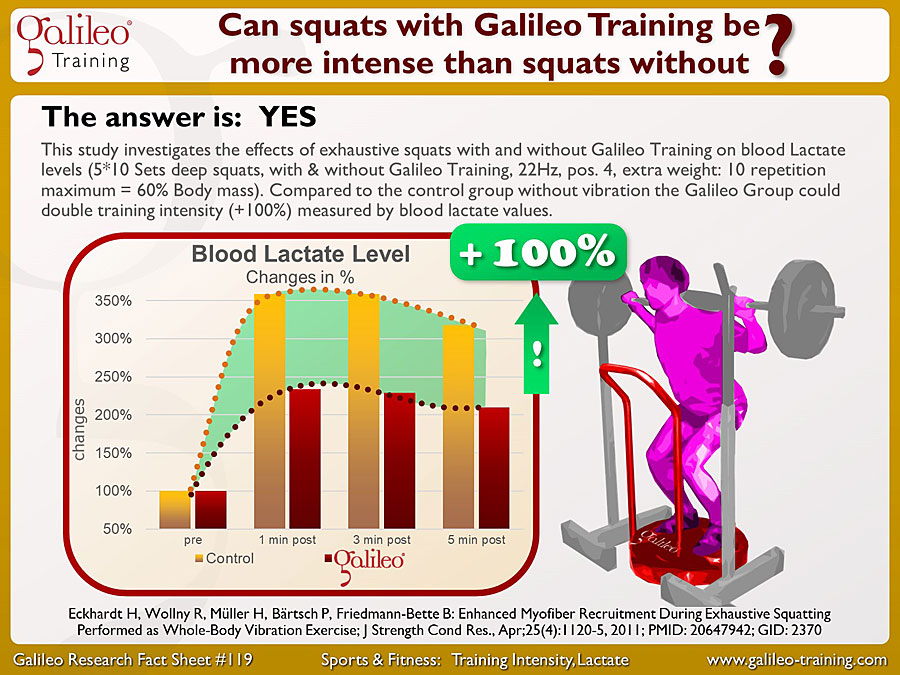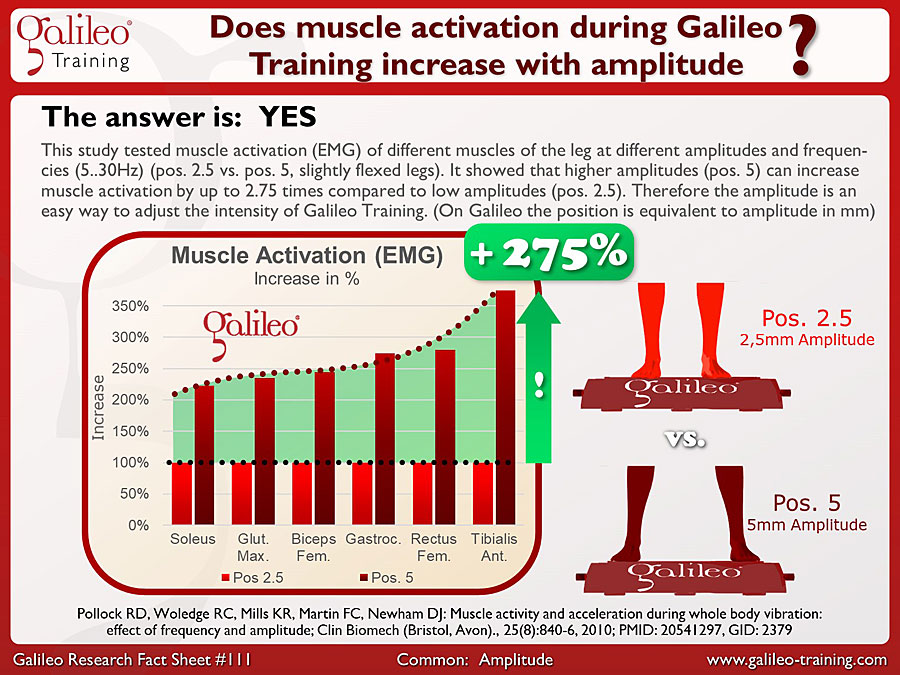This study documented the effects of Galileo Training in combination with squats on muscle temperature. Dynamic as well as static squats with and without Galileo were tested (26Hz, Pos. 3). The Galileo groups showed significant higher warming-up effects concerning muscle temperature with increases compared to the control group with +43% and +87%, showing that Galileo Training can be very effectively used for warm-up...
In the 2nd Berlin Bedrest Study (BBR2) the effects of Galileo Training against the expected bone loss was tested (55 days, 24Hz, 6x1 min. exhaustive, 3/week). The control groups receive no training or identical training with-out vibration (RE). Galileo showed compared to the control groups increased trabecular bone density at the spine (L1-L3) even 2 years after the active bedrest phase with maximum improvements of up to +12%...
This study investigates the effects of exhaustive squats with and without Galileo Training on muscle activation (EMG) (5*10 Sets deep squats, with & without Galileo Training, 22Hz, pos. 4, extra weight: 10RM = 60% Body mass). Compared to the control group without vibration the Galileo Group could almost triple muscle activation (+196%) during eight repetitions...
This study investigated the effects of Galileo Training on muscle function an balance in women age 52 to 60 (15-25Hz, 6 exercises, extra loads up to 30% body weight, pos.1-3, 35 min., 3/week, 12 weeks). The conventional group received identical exercises without vibration. The Galileo group showed identical results on muscle function but significantly higher results on all tested balance test with improvements o up to 61%...
This study investigates the effects of exhaustive squats with and without Galileo Training on blood Lactate levels (5*10 Sets deep squats, with & without Galileo Training, 22Hz, pos. 4, extra weight: 10 repetition maximum = 60% Body mass). Compared to the control group without vibration the Galileo Group could double training intensity (+100%) measured by blood lactate values...
This study documented the influence of posture during Galileo Training on the transmission of vibration to the head (25Hz, Pos. 3). The transmission of vibrations to the head was measured at 5 different postures (#1: upright, #2: 20° flexed legs,… #5: 20° flexed legs + special shoulder and neck position). The results show that posture and especially flexed legs can decrease vibration transmission by up to 65%...
This study documented the effects of Galileo Training on flexibility and concentric knee torque in physical active young women (25Hz, pos.3, 2*5 min., 10° flexed legs, 5/week, 3 weeks). The control group continued their weekly training. The Galileo group received Galileo Training only and no other training. The Galileo group could improve concentric knee torque by up to 8% and flexibility (Sit & Reach Test) by 13%...
This study investigated the effects of Galileo Training on muscle power in older community-dwelling adults ager 61 to 77 (15-25Hz, pos. 1, 70° knee-angle, 5*1min., 3/week, 6 weeks, increasing intensity). The control group did not perform any additional training. The Galileo group improved muscle power significantly, measured by the Timed Up & Go Test, (+12%) and using the Sit to Stand Test (+20%)...
This study tested muscle activation (EMG) of different muscles of the leg at different amplitudes and frequen-cies (5..30Hz) (pos. 2.5 vs. pos. 5, slightly flexed legs). It showed that higher amplitudes (pos. 5) can increase muscle activation by up to 2.75 times compared to low amplitudes (pos. 2.5). Therefore the amplitude is an easy way to adjust the intensity of Galileo Training. (On Galileo the position is equivalent to amplitude in mm)...
This study investigated short-term effects of Galileo Training at high frequencies (26Hz & 40Hz) on the max. isokinetic torque at the knee (0Hz, 26Hz (Pos.4), 40Hz (Pos.1.5), 90° knee angle (static), 10x60 s). The control group performed identical exercises without vibration. The Galileo group showed higher isokinetic eccentric knee torque of up to +14% (at 26Hz) which is equivalent to a difference of up to 41% vs. the control group...









